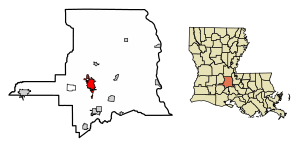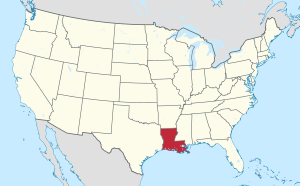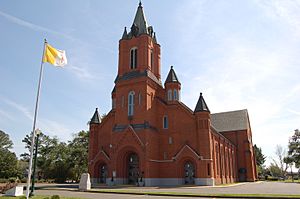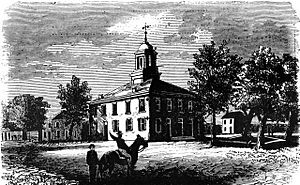Opelousas, Louisiana facts for kids
- Opelousas is also a common name of the flathead catfish.
Quick facts for kids
Opelousas, Louisiana
|
|
|---|---|
| City of Opelousas | |

Old Federal Courthouse in Opelousas, listed on the National Register of Historic Places
|
|
| Motto(s):
"Omnia ad Dei Gloriam - All Things to the Glory of God."
|
|

Location of Opelousas in St. Landry Parish, Louisiana.
|
|

Location of Louisiana in the United States
|
|
| Country | United States |
| State | Louisiana |
| Parish | St. Landry |
| Incorporated | 1821 |
| Area | |
| • Total | 9.68 sq mi (25.06 km2) |
| • Land | 9.67 sq mi (25.05 km2) |
| • Water | 0.00 sq mi (0.01 km2) |
| Elevation | 69 ft (21 m) |
| Population
(2020)
|
|
| • Total | 15,786 |
| • Density | 1,632.13/sq mi (630.18/km2) |
| Time zone | UTC−6 (CST) |
| • Summer (DST) | UTC−5 (CDT) |
| ZIP code |
70570
|
| Area code(s) | 337 |
| FIPS code | 22-58045 |
| Website | http://www.cityofopelousas.com |
Opelousas (French: Les Opélousas; Spanish: Los Opeluzás) is a small city in, and the parish seat of, St. Landry Parish, Louisiana, United States. Interstate 49 and U.S. Route 190 were constructed with a junction here. According to the 2020 census, Opelousas has a population of 15,786, and is currently declining at a rate of -1.16% annually and its population has decreased by -6.53% since the most recent census, which recorded a population of 16,634 in 2010. Opelousas is the principal city for the Opelousas-Eunice Micropolitan Statistical Area, which had an estimated population of 80,808 in 2020. Opelousas is also the fourth largest city in the Lafayette-Acadiana Combined Statistical Area, which has a population of 537,947.
Historically an area of settlement by French and Spanish Creoles, Creoles of color, and Acadians, Opelousas is the center of zydeco music. It celebrates its heritage at the Creoles of Color Heritage Folklife Center, one of the destinations on the new Louisiana African-American Heritage Trail. It is also the location of the Evangeline Downs Racetrack and Casino.
The city calls itself "the spice capital of the world", with production and sale of seasonings such as Tony Chachere's products, Targil Seasonings, Savoie's cajun meats and products, and LouAna Cooking Oil.
During the tenure of Sheriff Cat Doucet, from 1936 to 1940 and again from 1952 to 1968, the section of Opelousas along Highway 190 was a haven of gambling, the profits from which he skimmed a take.
Contents
Demographics
| Historical population | |||
|---|---|---|---|
| Census | Pop. | %± | |
| 1860 | 786 | — | |
| 1870 | 1,546 | 96.7% | |
| 1880 | 1,676 | 8.4% | |
| 1890 | 1,572 | −6.2% | |
| 1900 | 2,951 | 87.7% | |
| 1910 | 4,623 | 56.7% | |
| 1920 | 4,437 | −4.0% | |
| 1930 | 6,299 | 42.0% | |
| 1940 | 8,980 | 42.6% | |
| 1950 | 11,659 | 29.8% | |
| 1960 | 17,417 | 49.4% | |
| 1970 | 20,387 | 17.1% | |
| 1980 | 18,903 | −7.3% | |
| 1990 | 18,151 | −4.0% | |
| 2000 | 22,860 | 25.9% | |
| 2010 | 16,634 | −27.2% | |
| 2020 | 15,786 | −5.1% | |
| U.S. Decennial Census | |||
2020 census
| Race | Number | Percentage |
|---|---|---|
| White (non-Hispanic) | 2,799 | 17.73% |
| Black or African American (non-Hispanic) | 12,183 | 77.18% |
| Native American | 34 | 0.22% |
| Asian | 116 | 0.73% |
| Other/Mixed | 397 | 2.51% |
| Hispanic or Latino | 257 | 1.63% |
As of the 2020 United States census, there were 15,786 people, 6,248 households, and 3,527 families residing in the city.
2018
According to the 2018 United States Census estimate, 16,126 people reside within the city limits of Opelousas. The racial makeup of the city was 77.04% Black, 20.3% White, .04% Native American, .05% Asian, 0.0% Pacific Islander, .43% Other Race, 1.08% two or more races, and 1.06% was Hispanic or Latino of any race.
2010 census
The 2010 United States Census, 16,634 people resided in the city. The racial makeup of the city was 74.8% Black, 21.9% White, 0.3% Native American, 0.5% Asian, 0.0% Pacific Islander, 0.2% from some other race and 1.0% from two or more races; 1.2% was Hispanic or Latino of any race.
History
Early years
Opelousas takes its name from the Native American tribe Appalousa who had occupied the area before European contact.
The first recorded European arrived in the Appalousa Territory in 1690. He was a French coureur de bois (trapper and hunter). French traders arrived later to trade with the Appalousa Indians. In 1719, the French sent the first military to the Territory, when Ensign Nicolas Chauvin de la Frénière and two others were sent to patrol the area and in 1720, the French established Opelousas Post as a major trading organization for the developing area. The French encouraged immigration to Opelousas Post before they ceded Louisiana to Spain in 1762. By 1769 about 100 families, mostly French, were living in the Post. In 1767 Saint Landry Catholic Church was built. Don Alejandro O'Reilly, Spanish governor of Louisiana, issued a land ordinance to allow settlers in the frontier of the Opelousas Territory to acquire land grants. The first official land grant was made in 1782. Numerous settlers: French, Creoles and Acadians, mainly from the Attakapas Territory, came to the Opelousas Territory and acquired land grants.
After the Louisiana Purchase of 1803, settlers continued to arrive from St. Martinville. LeBon, Prejean, Thibodaux, Esprit, Nezat, Hebert, Babineaux, Mouton, and Provost were some of the early Creole families. (This was Creole as French born in Louisiana, see Louisiana Creole people.) Other early French Creole families were Roy, Barre, Guenard, Decuir, and Bail. In 1820, Alex Charles Barre, also a French Creole, founded Port Barre. His ancestors came from the French West Indies, probably after Haiti (St. Domingue) became independent. Jim Bowie and his family were said to have settled in the area circa 1813. In 1805, Opelousas became the seat of the newly formed St. Landry Parish, also known as the Imperial Parish of Louisiana. The year 1806 marked the beginning of significant construction in Opelousas. The first courthouse was constructed in the middle of the town. Later in 1806, Louisiana Memorial United Methodist Church was founded, becoming the first Methodist, as well as Protestant, church in Louisiana. Five years later, the first St. Landry Parish Police Jury met in Opelousas, keeping minutes in the two official languages of English and French. The city was incorporated in 1821.
American Civil War
European and American settlement was based on plantation agriculture, and both groups brought or purchased numerous enslaved Africans and African Americans to work as laborers in cotton cultivation. African Americans influenced all cultures as the people created a creolized cuisine and music. The long decline of cotton prices throughout the 19th century created economic problems worsened by the lack of employment diversity.
In 1862, after Baton Rouge fell to the Union troops during the Civil War, Opelousas was designated the state capital for nine months. The governor's mansion in Opelousas, which was the oldest remaining governor's mansion in Louisiana, was the victim of arson on July 14, 2016, and the structure was reduced to a chimney and its foundation. The one story mansion was located on the corner of Liberty and Grolee Streets, just west of the heart of town. An observation tower was removed from the top of the residence in the early 1900s but the remainder of the exterior was identical to its original construction in the 1850s. The entire roof section of heavy rafters was held in place by thousands of wooden pegs, not one nail could be found in the attic. There were plans to restore the building to some of its former splendor. The capitol was moved again in 1863, this time to Shreveport, when Union troops occupied Opelousas. During Reconstruction, the state government operated from New Orleans.
The Union forces led by General Nathaniel P. Banks who occupied Opelousas found what the historian John D. Winters describes as "a beautiful town boasting several churches, a fine convent, and a large courthouse," far superior in appearance to nearby Washington, also in St. Landry Parish. Early in 1864, jayhawkers began to make daring daytime raids in parts of St. Landry Parish near Opelousas. According to Winters in his The Civil War in Louisiana, the thieves "robbed the inhabitants in many instances of everything of value they possessed, but taking particularly all the fine horses and good arms they could find." Winters added that conscription in the area came to a standstill, as men could avoid the army by staying within the lines of the jayhawkers. The conscripts who did not join the lawless element stayed home until the state or the army could protect their families."
Reconstruction
After the defeat of the South and emancipation of slaves, many whites had difficulty accepting the changed conditions, especially as economic problems and dependence on agriculture slowed the South's recovery. Social tensions were high during Reconstruction. In 1868, a white mob rioted and killed 25-50 freedmen in Opelousas. Some reports put the number killed even higher, ranging from 200-300, and it was one of the single worst instances of Reconstruction violence in south Louisiana. Opelousas enacted ordinances following the abolition of slavery that served to greatly restrict the freedoms of black Americans. These codes required blacks to have a written pass from their employer to enter the town and to state the duration of their visit. Blacks were not allowed on the streets after 10 p.m, they could neither own a house nor reside in the town, unless the employee of a white person, and they were also not allowed in the town after 3 p.m. on Sundays.
Home of refugees
In 1880, the railroad reached Opelousas. In the late 19th century, New York City social services agencies arranged for resettlement of Catholic orphan children by sending them to western rural areas, including Opelousas, in Louisiana and other states. At least three Orphan Trains reached this city before 1929. Opelousas is the heart of a traditional Catholic region of French, Spanish, Canadian and French West Indian ancestry. Catholic families in Louisiana took in more than 2,000 mostly Catholic orphans to live in their rural farming communities.
In May 1927, Opelousas accepted thousands of refugees following the Great Mississippi Flood of 1927 in the Mississippi Delta. Heavy rains in northern and midwestern areas caused intense flooding in areas of Mississippi, Arkansas, and Louisiana downstream, especially after levées near Moreauville, Cecilia and Melville collapsed. More than 81 percent of St. Landry Parish suffered some flooding, with 77 percent of the inhabitants directly affected. People in more southern areas of Louisiana, especially those communities along Bayou Teche, were forced to flee their homes for areas that suffered less damage. By May 20, over 5,700 refugees were registered in Opelousas, which population at the time was only 6,000 people. Many of the refugees later returned to their homes and begin the rebuilding process.
Festivals
The Yambilee Festival began in 1946 and is the oldest festival held each year in Opelousas. It starts on the Wednesday before the last full weekend of October and continues throughout the weekend with events including concerts, cooking competitions, a parade and beauty pageants.
Since 1982, Opelousas has hosted the Original Southwest Louisiana Zydeco Festival. Usually held the Saturday before Labor Day at Zydeco Park in Plaisance, the festival features a day of performances by Zydeco musicians, with the goal of keeping the genre alive.
Additional annual events include:
- Frank's Downtown Gumbo Cook-off - January
- Zydeco Extravaganza - May
- Juneteenth Festival- 3rd Saturday every June, celebration of end of the Civil War and emancipation of slaves
- Holy Ghost Creole Festival - 1st weekend of November, near All Saints Day (Nov.1)
- Christmas Lighting of Le Vieux Village- 1st Friday every December
- Frank's Mardi Gras Parade- Mardi Gras (Tuesday before Ash Wednesday in French Catholic tradition)
- Opelousas Mardi Gras Celebration/Street Dance on Court St.- Mardi Gras
Miscellany
Musician Billy Cobham recorded a song called "Opelousas" on his 1978 album Simplicity of Expression - Depth of Thought (Columbia Records JC 35457).
1980s synthpop musician Thomas Dolby speaks of Opelousas in the first person in the song I Love You Goodbye from his 1992 album Astronauts & Heretics. The folk-rock singer Lucinda Williams mentions Opelousas in the song Concrete and Barbed Wire from her critically acclaimed album Car Wheels on a Gravel Road. Singer-songwriter and comedian Henry Phillips mentions Opelousas as one of the venues in his song I'm In Minneapolis (You're In Hollywood).
Economy
The primary industries in Opelousas are agriculture, oil, manufacturing, wholesale, and retail.
The horse racing track Evangeline Downs relocated to Opelousas from its former home in Carencro, Louisiana, in 2003. It employs over 600 workers.
Opelousas is also home to Tony Chachere, a Louisiana spice company with a worldwide reach. The company makes a variety of seasoning blends, sauces, marinades, and other products.
In September 1999, Wal-Mart opened a large distribution center just north of the city. It is generating an $89 million impact per year to the area, employing over 600 full-time workers.
Sports
Opelousas was home to the Opelousas Indians, a minor league baseball franchise that was based in Opelousas in 1907, 1932 and 1934–1941. The Indians were members of the Gulf Coast League (1907) and Evangeline League (1934-1941). The team played at Elementary School Park. The Opelousas Orphans played a portion of the 1932 season in the Cotton States League. Opelousas was an affiliate of the Cleveland Indians (1935-1937, 1939).
Education
Opelousas is home to several public and private schools. Opelousas has many public high schools, which are Opelousas Senior High, Northwest High School, and Magnet Academy for Cultural Arts. Opelousas Junior High serves as the area middle school. The city has seven public elementary schools. It is also home to one of the campuses of South Louisiana Community College.
The private schools are religiously based, including Opelousas Catholic School, Westminster Christian Academy, Apostolic Christian Academy, New Hope Christian Academy, and Family Worship Christian Academy.
Notable people
Athletes
- Rod Milburn, 1972 Summer Olympics gold medalist
- Lloyd Mumphord, NFL cornerback and special-teams captain for Miami Dolphins during their perfect season (1972–73), two-time Super Bowl champion
- Marvin White, safety for the Cincinnati Bengals
- Devery Henderson, wide receiver for the New Orleans Saints
- CeeDee Lamb, wide receiver for the Dallas Cowboys
- Daniel Baldridge, offensive tackle for the Jacksonville Jaguars and the Tennessee Titans
Clergy
- W. C. Friley, Baptist clergyman who, through a series of revival meetings in 1880, helped to establish First Baptist Church Opelousas.
- Dominic Carmon, Roman Catholic bishop
- Charles Michael Jarrell, Roman Catholic bishop
Culinary
- Chef Tony Chachere was born in Opelousas; the town is home to his company, Tony Chachere Creole Foods.
- Chef Paul Prudhomme
Entertainers
- Rod Bernard, American singer who helped to pioneer the musical genre known as "swamp pop", which combined New Orleans-style rhythm and blues, country and western, and Cajun music.
- Tex Brashear, voice-over/cartoon voice actor
- Clifton Chenier, legendary zydeco musician
- Richard Eastham (1916–2005), actor
- Mabel Sonnier Savoie, American singer, guitarist
Historians
- Winston De Ville, Colonial Louisiana and Mississippi Valley historian, genealogist, and author
- Carl Brasseaux, historian of French Colonial Louisiana
Politicians
- Cindy Courville, first US Ambassador to the African Union
- Jay Dean, mayor of Longview, Texas, 2005–2015; Republican member of the Texas House of Representatives, was born in Opelousas in 1953.
- Cat Doucet, Sheriff of St. Landry Parish, 1936–40; 1952–68
- Gilbert L. Dupré, state representative and district court judge for St. Landry Parish
- H. Garland Dupré, state representative and U.S. representative for Louisiana's 2nd congressional district in New Orleans, was born in Opelousas in 1873.
- Jacques Dupré, 8th Governor of Louisiana; fought in Battle of New Orleans, and served as a state politician from 1816 to 1848. Owned the largest ranch in Louisiana in 1830.
- Ivan L. R. Lemelle, Federal Judge, U.S. District Court, Eastern District of Louisiana, and former U.S. Magistrate Judge of the same district.
- Charles Nash, African American Republican Representative after during the Reconstruction era
- André B. Roman, 9th Governor of Louisiana serving two non-consecutive terms. Speaker of the Louisiana House of Representatives, 1822 to 1826. State politician from 1818 to 1843.
- Louisiana Chief Justice Albert Tate, Jr., who later served on the United States Fifth Circuit Court of Appeals, based in New Orleans.
Others
- Jim Bowie, legendary adventurer and hero of the Alamo, lived in Opelousas for a time.
- Rezin Bowie, older brother of Alamo hero Jim Bowie and inventor of the famous Bowie knife, lived in Opelousas and married and converted to Catholicism at St. Landry Catholic Church in Opelousas.
- Confederate Brigadier General J.J. Alfred Mouton, CSA, was born in Opelousas on February 29, 1829; he served under Confederate General Richard Taylor, and was killed during the Battle of Mansfield, Louisiana.
- Antoinette Frank, death-row inmate at the Louisiana Correctional Institute
- Georgia Ann Robinson, first African American woman to serve as an officer in the Los Angeles Police Department
See also
 In Spanish: Opelousas para niños
In Spanish: Opelousas para niños




